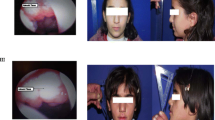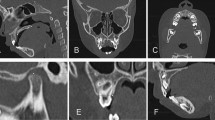Abstract
No studies for the role of adenotonsillar hypertrophy in development of dentofacial abnormalities have been performed in Asian pediatric population. Thus, we aimed to investigate the relationship between adenotonsillar hypertrophy and dentofacial abnormalities in Korean children. The present study included consecutive children who visited a pediatric clinic for sleep-disordered breathing due to habitual mouth breathing, snoring or sleep apnea. Their palatine tonsils and adenoids were graded by oropharyngeal endoscopy and lateral cephalometry. Anterior open bite, posterior crossbite, and Angle’s class malocclusions were evaluated for dentofacial abnormality. The receiver-operating characteristic curve analysis was used to identify age cutoffs to predict dentofacial abnormality. A total of 1,083 children were included. The presence of adenotonsillar hypertrophy was significantly correlated with the prevalence of dentofacial abnormality [adjusted odds ratio = 4.587, 95 % CI (2.747–7.658)] after adjusting age, sex, body mass index, allergy, and Korean version of obstructive sleep apnea-18 score. The cutoff age associated with dentofacial abnormality was 5.5 years (sensitivity = 75.5 %, specificity = 67 %) in the children with adenotonsillar hypertrophy and 6.5 years (sensitivity = 70.6 %, specificity = 57 %) in those without adenotonsillar hypertrophy. In conclusion, adenotonsillar hypertrophy may be a risk factor for dentofacial abnormalities in Korean children and early surgical intervention could be considered with regards to dentofacial abnormality.


Similar content being viewed by others
References
Jabbari Moghaddam Y, Rafeey M, Radfar R (2009) Comparative assessment of Helicobacter pylori colonization in children tonsillar tissues. Int J Pediatr Otorhinolaryngol 73(9):1199–1201
Huang SW, Giannoni C (2001) The risk of adenoid hypertrophy in children with allergic rhinitis. Ann Allergy Asthma Immunol 87(4):350–355
Sadeghi-Shabestari M, Jabbari Moghaddam Y, Ghaharri H (2011) Is there any correlation between allergy and adenotonsillar tissue hypertrophy? Int J Pediatr Otorhinolaryngol 75(4):589–591
Bixler EO, Vgontzas AN, Lin HM, Liao D, Calhoun S, Vela-Bueno A, Fedok F, Vlasic V, Graff G (2009) Sleep disordered breathing in children in a general population sample: prevalence and risk factors. Sleep 32(6):731–736
O’Brien LM, Holbrook CR, Mervis CB, Klaus CJ, Bruner JL, Raffield TJ, Rutherford J, Mehl RC, Wang M, Tuell A, Hume BC, Gozal D (2003) Sleep and neurobehavioral characteristics of 5- to 7-year-old children with parentally reported symptoms of attention-deficit/hyperactivity disorder. Pediatrics 111(3):554–563
Kang KT, Chou CH, Weng WC, Lee PL, Hsu WC (2013) Associations between adenotonsillar hypertrophy, age, and obesity in children with obstructive sleep apnea. PLoS One 8(10):e78666
Tatlipinar A, Biteker M, Meric K, Bayraktar GI, Tekkesin AI, Gokceer T (2012) Adenotonsillar hypertrophy: correlation between obstruction types and cardiopulmonary complications. Laryngoscope 122(3):676–680
Behlfelt K, Linder-Aronson S, McWilliam J, Neander P, Laage-Hellman J (1989) Dentition in children with enlarged tonsils compared to control children. Eur J Orthod 11(4):416–429
Principato JJ (1991) Upper airway obstruction and craniofacial morphology. Otolaryngol Head Neck Surg 104(6):881–890
Defabjanis P (2003) Impact of nasal airway obstruction on dentofacial development and sleep disturbances in children: preliminary notes. J Clin Pediatr Dent 27(2):95–100
Oulis CJ, Vadiakas GP, Ekonomides J, Dratsa J (1994) The effect of hypertrophic adenoids and tonsils on the development of posterior crossbite and oral habits. J Clin Pediatr Dent 18(3):197–201
Sosa FA, Graber TM, Muller TP (1982) Postpharyngeal lymphoid tissue in Angle Class I and Class II malocclusions. Am J Orthod 81(4):299–309
Gois EG, Ribeiro-Junior HC, Vale MP, Paiva SM, Serra-Negra JM, Ramos-Jorge ML, Pordeus IA (2008) Influence of nonnutritive sucking habits, breathing pattern and adenoid size on the development of malocclusion. Angle Orthod 78(4):647–654
Hultcrantz E, Larson M, Hellquist R, Ahlquist-Rastad J, Svanholm H, Jakobsson OP (1991) The influence of tonsillar obstruction and tonsillectomy on facial growth and dental arch morphology. Int J Pediatr Otorhinolaryngol 22(2):125–134
Mahony D, Karsten A, Linder-Aronson S (2004) Effects of adenoidectomy and changed mode of breathing on incisor and molar dentoalveolar heights and anterior face heights. Aust Orthod J 20(2):93–98
Weider DJ, Baker GL, Salvatoriello FW (2003) Dental malocclusion and upper airway obstruction, an otolaryngologist’s perspective. Int J Pediatr Otorhinolaryngol 67(4):323–331
Wysocki J, Krasny M, Skarzynski PH (2009) Patency of nasopharynx and a cephalometric image in the children with orthodontic problems. Int J Pediatr Otorhinolaryngol 73(12):1803–1809
Souki BQ, Pimenta GB, Souki MQ, Franco LP, Becker HM, Pinto JA (2009) Prevalence of malocclusion among mouth breathing children: do expectations meet reality? Int J Pediatr Otorhinolaryngol 73(5):767–773
Lofstrand-Tidestrom B, Hultcrantz E (2010) Development of craniofacial and dental arch morphology in relation to sleep disordered breathing from 4 to 12 years. Effects of adenotonsillar surgery. Int J Pediatr Otorhinolaryngol 74(2):137–143
Hultcrantz E, Lofstrand Tidestrom B (2009) The development of sleep disordered breathing from 4 to 12 years and dental arch morphology. Int J Pediatr Otorhinolaryngol 73(9):1234–1241
Friedman M, Ibrahim H, Bass L (2002) Clinical staging for sleep-disordered breathing. Otolaryngol Head Neck Surg 127(1):13–21
Kim SY, Lee WH, Rhee CS, Lee CH, Kim JW (2013) Regrowth of the adenoids after coblation adenoidectomy: cephalometric analysis. Laryngoscope 123(10):2567–2572
Pires MG, Di Francesco RC, Grumach AS, Mello JF Jr (2005) Evaluation of inspiratory pressure in children with enlarged tonsils and adenoids. Braz J Otorhinolaryngol 71(5):598–601
Moorrees CF, Gron AM, Lebret LM, Yen PK, Frohlich FJ (1969) Growth studies of the dentition: a review. Am J Orthod 55(6):600–616
Proffit WR, Fields HW Jr, Moray LJ (1998) Prevalence of malocclusion and orthodontic treatment need in the United States: estimates from the NHANES III survey. Int J Adult Orthodon Orthognath Surg 13(2):97–106
Huynh NT, Morton PD, Rompre PH, Papadakis A, Remise C (2011) Associations between sleep-disordered breathing symptoms and facial and dental morphometry, assessed with screening examinations. Am J Orthod Dentofacial Orthop 140(6):762–770
Ameli F, Brocchetti F, Semino L, Fibbi A (2007) Adenotonsillectomy in obstructive sleep apnea syndrome. Proposal of a surgical decision-taking algorithm. Int J Pediatr Otorhinolaryngol 71(5):729–734
Kulnis R, Nelson S, Strohl K, Hans M (2000) Cephalometric assessment of snoring and nonsnoring children. Chest 118(3):596–603
Lowe AA, Ozbek MM, Miyamoto K, Pae EK, Fleetham JA (1997) Cephalometric and demographic characteristics of obstructive sleep apnea: an evaluation with partial least squares analysis. Angle Orthod 67(2):143–153
Marino A, Malagnino I, Ranieri R, Villa MP, Malagola C (2009) Craniofacial morphology in preschool children with obstructive sleep apnoea syndrome. Eur J Paediatr Dent 10(4):181–184
Pirila-Parkkinen K, Pirttiniemi P, Nieminen P, Tolonen U, Pelttari U, Lopponen H (2009) Dental arch morphology in children with sleep-disordered breathing. Eur J Orthod 31(2):160–167
Bresolin D, Shapiro PA, Shapiro GG, Chapko MK, Dassel S (1983) Mouth breathing in allergic children: its relationship to dentofacial development. Am J Orthod 83(4):334–340
Trask GM, Shapiro GG, Shapiro PA (1987) The effects of perennial allergic rhinitis on dental and skeletal development: a comparison of sibling pairs. Am J Orthod Dentofacial Orthop 92(4):286–293
Shapiro PA (1988) Effects of nasal obstruction on facial development. J Allergy Clin Immunol 81(5 Pt 2):967–971
Linder-Aronson S, Woodside DG, Lundstrom A (1986) Mandibular growth direction following adenoidectomy. Am J Orthod 89(4):273–284
Zettergren-Wijk L, Forsberg CM, Linder-Aronson S (2006) Changes in dentofacial morphology after adeno-/tonsillectomy in young children with obstructive sleep apnoea–a 5-year follow-up study. Eur J Orthod 28(4):319–326
Author information
Authors and Affiliations
Corresponding author
Rights and permissions
About this article
Cite this article
Kim, DK., Rhee, C.S., Yun, PY. et al. Adenotonsillar hypertrophy as a risk factor of dentofacial abnormality in Korean children. Eur Arch Otorhinolaryngol 272, 3311–3316 (2015). https://doi.org/10.1007/s00405-014-3407-6
Received:
Accepted:
Published:
Issue Date:
DOI: https://doi.org/10.1007/s00405-014-3407-6




